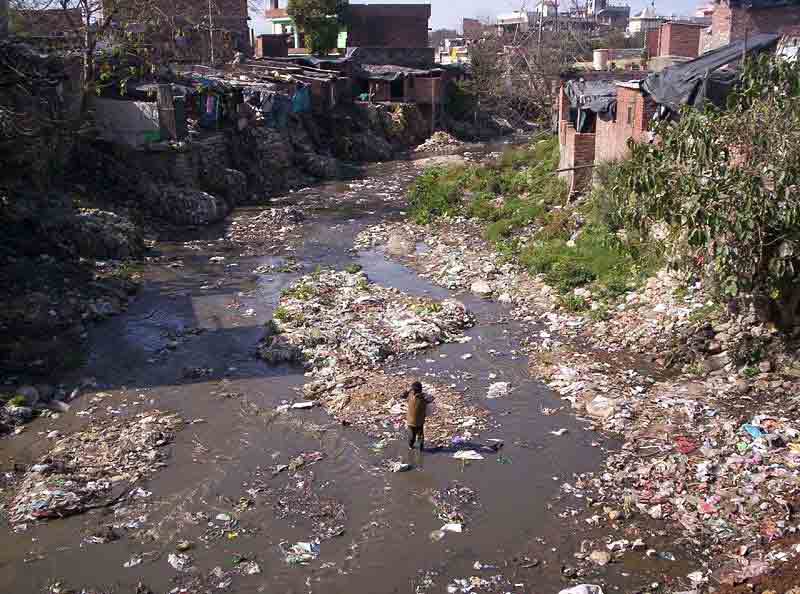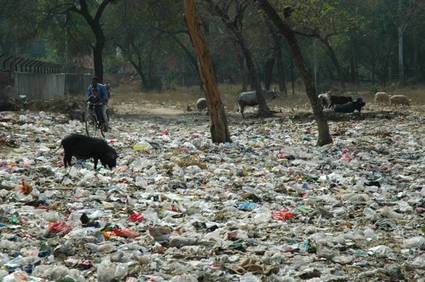10 Major Environmental Challenges Faced by India
Some of the most important environmental challenges faced by India are as follows:
It is essential to make the public aware of the formidable consequences of the Environmental Degradation, if not retorted and reformative measures undertaken would result in the extinction of life.
 We are facing various environmental challenges. It is essential to get the country acquainted with these challenges so that their acts may be eco-friendly. Some of these challenges are as under:
We are facing various environmental challenges. It is essential to get the country acquainted with these challenges so that their acts may be eco-friendly. Some of these challenges are as under:
1. Growing Population:
A population of over thousands of millions is growing at 2.11 per cent every year. It puts considerable pressure on its natural resources and reduces the gains of development. Hence, the greatest challenge before us is to limit the population growth. Although population control does automatically lead to development, yet the development leads to a decrease in population growth rates.
2. Poverty:
India has often been described a rich land with poor people. The poverty and environmental degradation have a nexus between them. The vast majority of our people are directly dependent on the nature resources of the country for their basic needs of food, fuel shelter and fodder. About 40% of our people are still below the poverty line.
Environment degradation has adversely affected the poor who depend upon the resources of their immediate surroundings. Thus, the challenge of poverty and the challenge environment degradation are two facts of the same challenge. The population growth is essentially a function of poverty. Because, to the very poor, every child is an earner and helper and global concerns have little relevance for him.
3. Agricultural Growth:
The people must be acquainted with the methods to sustain and increase agricultural growth with damaging the environment. High yielding varieties have caused soil salinity and damage to physical structure of soil.
4. Need to Ground Water:
It is essential of rationalizing the use of groundwater. Factors like community wastes, industrial effluents and chemical fertilizers and pesticides have polluted our surface water and affected quality of the groundwater.
It is essential to restore the water quality of our rivers and other water body as lakes is an important challenge. It so finding our suitable strategies for consecration of water, provision of safe drinking water and keeping water bodies clean which are difficult challenges is essential.
5. Development and Forests:
Forests serve catchments for the rivers. With increasing demand of water, plan to harness the mighty river through large irrigation projects were made. Certainly, these would submerge forests; displace local people, damage flora and fauna.
As such, the dams on the river Narmada, Bhagirathi and elsewhere have become areas of political and scientific debate. Forests in India have been shrinking for several centuries owing to pressures of agriculture and other uses. Vast areas that were once green, stand today as wastelands.
These areas are to be brought back under vegetative cover. The tribal communities inhabiting forests respects the trees and birds and animal that gives them sustenance. We must recognize the role of these people in restoring and conserving forests.
The modern knowledge and skills of the forest dept. should be integrated with the traditional knowledge and experience of the local communities. The strategies for the joint management of forests should be evolved in a well planned way.
6. Degradation of Land:
At present out of the total 329 mha of land, only 266 mha possess any potential for production. Of this, 143 mha is agricultural land nearly and 85 suffer from varying degrees of soil degradation. Of the remaining 123 mha, 40 are completely unproductive.
The remaining 83 mha is classified as forest land, of which over half is denuded to various degrees. Nearly 406 million head of livestock have to be supported on 13 mha, or less than 4 per cent of the land classified as pasture land, most of which is overgrazed. Thus, our of 226 mha, about 175 mha or 66 per cent is degraded to varying degrees. Water and wind erosion causes further degradation of almost 150 mha.
7. Reorientation of Institutions:
The people should be roused to orient institutions, attitudes and infrastructures, to suit conditions and needs today. The change has to be brought in keeping in view India’s traditions for resources use managements and education etc. Change should be brought in education, in attitudes, in administrative procedures and in institutions. Because it affects way people view technology resources and development.
8. Reduction of Genetic Diversity:
At present most wild genetic stocks have been disappearing from nature. Wilding including the Asiatic Lion are facing problem of loss of genetic diversity. The protected areas network like sanctuaries, national parks, biosphere reserves are isolating populations. So, they are decreasing changes of one group breeding with another. Remedial steps are to be taken to check decreasing genetic diversity.
9. Evil Consequences of Urbanization:
Nearly 27 per cent Indians live in urban areas. Urbanization and industrialization has given birth to a great number of environmental problems that need urgent attention. Over 30 per cent of urban Indians live in slums. Out of India’s 3,245 towns and cities, only 21 have partial or full sewerage and treatment facilities. Hence, coping with rapid urbanization is a major challenge.
10. Air and Water Population:
Majority of our industrial plants are using out-dated and population technologies and makeshift facilities devoid of any provision of treating their wastes. A great number of cities and industrial areas that have been identified as the worst in terms of air and water pollution.
Acts are enforced in the country, but their implement is not so easy. The reason is their implementation needs great resources, technical expertise, political and social will. Again the people are to be made aware of these rules. Their support is indispensable to implement these rules.
